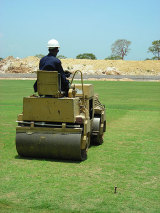Ten overs to go, 80 needed
One of the delights of watching cricket in the West Indies is the relaxed nature of the Caribbean game. In England they confiscate your beer cans; in Barbados they make sure you know where the rum shop is
Paul Kelso
30-Dec-2006
|
|

|
Such incidents satisfy the tourist cliché of island life but they also demonstrate the huge challenge the West Indies board accepted when chosen to host the 2007 World Cup, the biggest event ever held in this beautiful but disparate region. With 12 venues in the nine host nations begun from scratch or significantly overhauled, an unprecedented degree of co-operation has been required to give the tournament a chance of success.
The chief executive of the World Cup project, Chris Dehring, recently compared the project to a side chasing a large target in the closing overs of a one-day international. To an Englishman that suggested disaster but Dehring is imbued with a confidence like that of the current young West Indies side. "I just meant that we have to score off every ball," he says. "I am tremendously excited about this project because we have made such progress. We are over the hump in terms of construction. All the major work has been done and we are now into overlay and completion work on the venues. Sure, it is pedal-to-the-metal time but everyone involved knows their
responsibility."
With the first ball bowled on March 13, the project is approaching a moment of truth. In November the ICC conducted a rigorous inspection of the eight islands plus Guyana that will host games next spring. What they saw will have filled them with equal measures of confidence and trepidation.
In some of the venues progress is startling. In Guyana and Antigua, where the new Sir Vivian
Richards Stadium replaces the fondly remembered Rec, new World Cup countdown arenas approaching completion stand where 24 months ago there was only cow pasture. In Grenada
progress has also been made. After falling badly behind schedule, 500 labourers have been working on round-the-clock shifts to meet the March deadline. In Trinidad three new grandstands and a media centre at the Queen's Park Oval are nearing completion, even if the Brian Lara Stadium, a warm-up arena, is running late. In Barbados, too, organisers claim that the rebuilt Kensington Oval is only a matter of weeks behind schedule, though the ICC delegation may not
have been inspired by a sign outside advertising jobs for skilled labourers.
Of most concern is the state of the pitches. The outfields, organisers insist, will be a revelation. It is the square that matters most, however, and here there is real cause for alarm. In Antigua undulations in the surface have been identified and organisers are considering what to do. Meanwhile Guyana's square has not seeded as well as hoped and is behind schedule.
The organisers explain that a team of agronomists have conducted rigorous tests on each ground and are satisfied but there is no substitute for cricket to reveal the quality of a pitch. Every
ground has hosted a game according to the organising committee but, as Hampshire's
Rose Bowl has demonstrated, time is needed for some things that money alone cannot do. With some venues using relaid squares, a leap of faith is required to believe there will not be any repeat of the Sabina Park debacle in 1997-98 when a corrugated pitch led to the abandonment of a Test.
Dehring's task should not be underestimated. Galvanising nine different governments to co-operate in a region notorious for in-fighting has been a huge challenge. This selfish tendency is called "crabantics" in the Caribbean, after the behaviour of crabs when captured in
a bucket. In their haste to get out they cling on to the individual nearest the top, pulling it down and ensuring that none escapes. Cricket has helped overcome this tendency: historically the West Indies side has been the one successful example of regional co-operation.
"Ten years ago if you said that nine governments would combine to pass legislation for the World Cup, and that this scale of construction would happen, people would havesaid you were mad," Dehring says. "Since the 1930s we have taken cricket in the Caribbean for granted
but now we have the chance to change the game for ever. We have spent more than $300m and used it to overhaul everything. It has been a fantastic exercise."
It is not over yet and the cricket world waits to see if the wet cement is confined to the toilets
come the spring.
Paul Kelso is a sports news reporter for The Guardian
This article was first published in the January issue of The Wisden Cricketer.
Click here for further details.
Click here for further details.